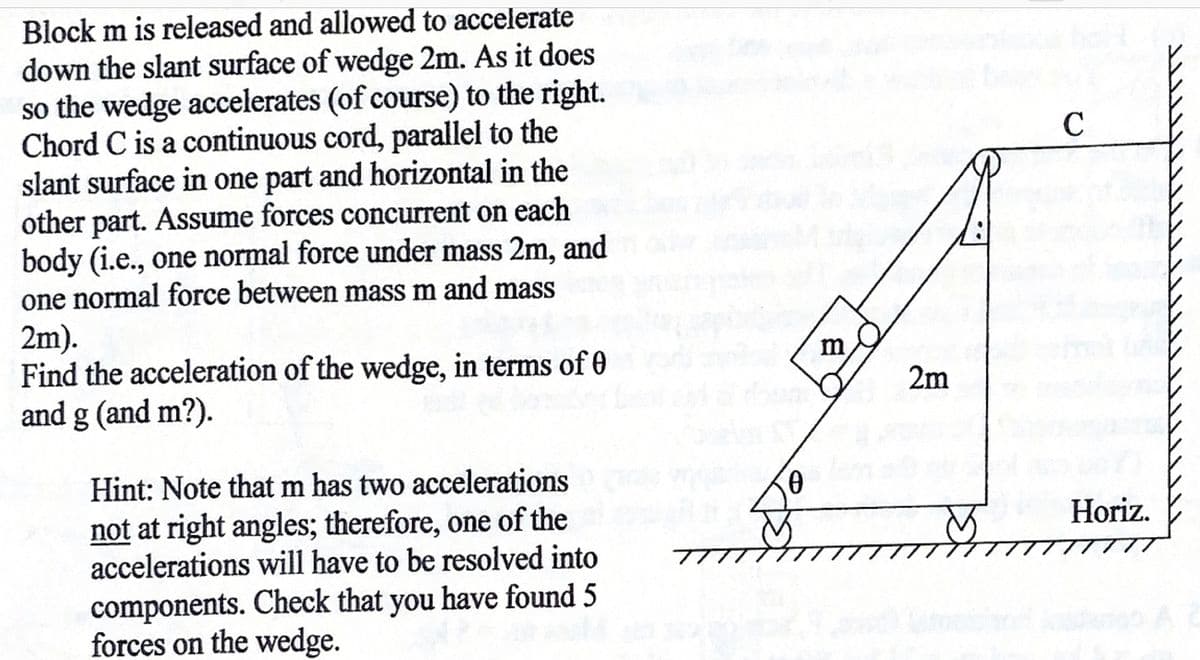Block m is released and allowed to accelerate down the slant surface of wedge 2m. As it does so the wedge accelerates (of course) to the right. Chord C is a continuous cord, parallel to the slant surface in one part and horizontal in the other part. Assume forces concurrent on each body (i.e., one normal force under mass 2m, and one normal force between mass m and mass C 2m). Find the acceleration of the wedge, in terms of 0 and g (and m?). m 2m Hint: Note that m has two accelerations not at right angles; therefore, one of the accelerations will have to be resolved into Horiz. components. Check that you have found 5 forces on the wedge.
Block m is released and allowed to accelerate down the slant surface of wedge 2m. As it does so the wedge accelerates (of course) to the right. Chord C is a continuous cord, parallel to the slant surface in one part and horizontal in the other part. Assume forces concurrent on each body (i.e., one normal force under mass 2m, and one normal force between mass m and mass C 2m). Find the acceleration of the wedge, in terms of 0 and g (and m?). m 2m Hint: Note that m has two accelerations not at right angles; therefore, one of the accelerations will have to be resolved into Horiz. components. Check that you have found 5 forces on the wedge.
University Physics Volume 1
18th Edition
ISBN:9781938168277
Author:William Moebs, Samuel J. Ling, Jeff Sanny
Publisher:William Moebs, Samuel J. Ling, Jeff Sanny
Chapter5: Newton's Law Of Motion
Section: Chapter Questions
Problem 2CQ: Taking a frame attached to Earth as inertial, which of the following objects cannot have inertial...
Related questions
Question
Solve the following problem, the right answer is a= g sin (theta) / (4-2cos(theta))

Transcribed Image Text:Block m is released and allowed to accelerate
down the slant surface of wedge 2m. As it does
so the wedge accelerates (of course) to the right.
Chord C is a continuous cord, parallel to the
slant surface in one part and horizontal in the
other part. Assume forces concurrent on each
body (i.e., one normal force under mass 2m, and
one normal force between mass m and mass
2m).
Find the acceleration of the wedge, in terms of 0
and g (and m?).
C
m
2m
Hint: Note that m has two accelerations
not at right angles; therefore, one of the
accelerations will have to be resolved into
Horiz.
components. Check that you have found 5
forces on the wedge.
Expert Solution
This question has been solved!
Explore an expertly crafted, step-by-step solution for a thorough understanding of key concepts.
This is a popular solution!
Trending now
This is a popular solution!
Step by step
Solved in 2 steps with 2 images

Knowledge Booster
Learn more about
Need a deep-dive on the concept behind this application? Look no further. Learn more about this topic, physics and related others by exploring similar questions and additional content below.Recommended textbooks for you

University Physics Volume 1
Physics
ISBN:
9781938168277
Author:
William Moebs, Samuel J. Ling, Jeff Sanny
Publisher:
OpenStax - Rice University

Classical Dynamics of Particles and Systems
Physics
ISBN:
9780534408961
Author:
Stephen T. Thornton, Jerry B. Marion
Publisher:
Cengage Learning

University Physics Volume 1
Physics
ISBN:
9781938168277
Author:
William Moebs, Samuel J. Ling, Jeff Sanny
Publisher:
OpenStax - Rice University

Classical Dynamics of Particles and Systems
Physics
ISBN:
9780534408961
Author:
Stephen T. Thornton, Jerry B. Marion
Publisher:
Cengage Learning